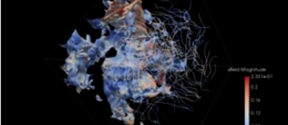Astroinformatics (external link)
Simulations of turbulence and magnetism in astrophysical objects

Magnetic fields grow quickly even at early cosmological times, suggesting the action of a small-scale dynamo (SSD) in the interstellar medium of galaxies. Many studies have focused on idealized turbulent driving of the SSD. Here we simulate more realistic supernova-driven turbulence to determine whether it can drive an SSD. Magnetic field growth occurring in our models appears inconsistent with simple tangling of magnetic fields, but consistent with SSD action, reproducing and confirming models by Balsara et al. (2004) that did not include physical resistivity η. We vary η, as well as the numerical resolution and supernova rate, σ̇, to delineate the regime in which an SSD occurs. For a given σ̇ we find convergence for SSD growth rate with resolution of a parsec. For σ̇ ' σ̇ sn , with σ̇ sn the solar neighborhood rate, the critical resistivity below which an SSD occurs is 0.005 > η crit > 0.001 kpc km/s , and this increases with the supernova rate. Across the modeled range of 0.5–4 pc resolution we find that for η < η crit , the SSD saturates at about 5% of kinetic energy equipartition, independent of growth rate. In the range 0.2 σ̇ sn ≤ σ̇ ≤ 8 σ̇ sn growth rate increases with σ̇. SSDs in the supernova-driven interstellar medium commonly exhibit erratic growth.

Simulations of turbulence and magnetism in astrophysical objects

cs.aalto.fi